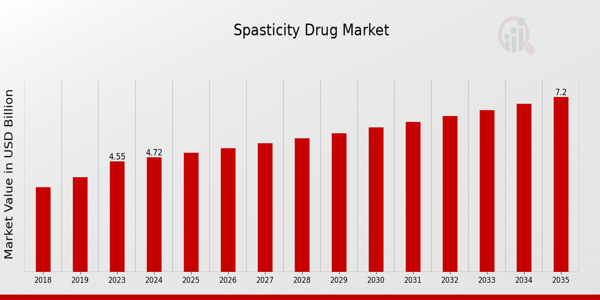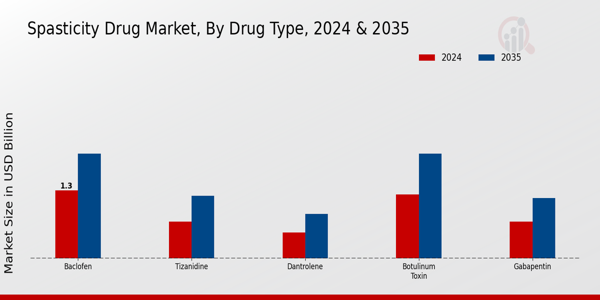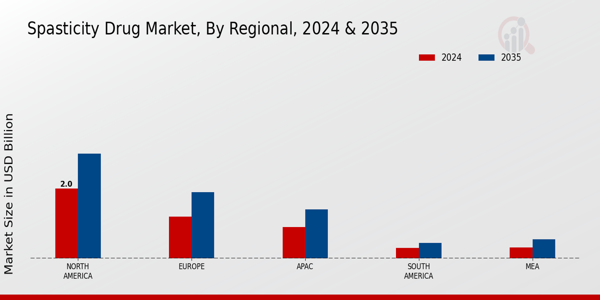Spasticity Drug Market Overview
The Spasticity Drug Market Size was estimated at 4.55 (USD Billion) in 2023.The Spasticity Drug Market is expected to grow from 4.72(USD Billion) in 2024 to 7.2 (USD Billion) by 2035. The Spasticity Drug Market CAGR (growth rate) is expected to be around 3.91% during the forecast period (2025 - 2035).
Key Spasticity Drug Market Trends Highlighted
The Spasticity Drug Market is influenced by several key drivers, including the rising prevalence of neurological disorders and increased awareness regarding treatment options. As the population ages, conditions like multiple sclerosis, cerebral palsy, and stroke-related spasticity are becoming more common. This surge has led to a greater demand for effective medications aimed at managing muscle stiffness and enhancing patients' quality of life. Additionally, advancements in drug formulation and technology continue to support the development of innovative treatments, making it an appealing sector for investors and pharmaceutical companies. There are numerous opportunities to be explored in this market, particularly in underserved regions where access to healthcare remains limited. Expanding markets in developing countries presents a chance for pharmaceutical companies to introduce effective treatment options.
Collaborations between biotech firms and established pharmaceutical companies can lead to the development of novel therapies that target specific patient needs, further driving market growth. The integration of digital health technologies, including telemedicine, has the potential to improve patient adherence and access to treatments, thus expanding the market's reach. Trends in recent times indicate a shift towards personalized medicine and targeted therapies, which address the unique needs of individuals suffering from spasticity.The rising focus on quality of life has prompted research into alternative therapies and management strategies that complement traditional drug therapies.
Furthermore, the adoption of innovative delivery systems, such as extended-release formulations and injectables, aims to improve patient experiences. As the market continues to evolve, the emphasis on comprehensive care and patient-centered approaches is likely to define its future trajectory. The ongoing research and development efforts in this field are expected to yield effective treatment options, transforming the landscape of spasticity management.

Source: Primary Research, Secondary Research, MRFR Database and Analyst Review
Spasticity Drug Market Drivers
Increasing Prevalence of Neurological Disorders
The Spasticity Drug Market is greatly affected by the growing number of neurologic disorders. The increasing diagnoses of multiple sclerosis, stroke, and cerebral palsy create a higher demand for treatments that effectively mitigate spasticity, furthering the development of the industry. Spasticity is often secondary to other disorders as well. This surge in patients creates a greater demand for effective therapies but also motivates pharmaceutical companies to further innovative research in the development of new spasticity medications.
In response, new drug formulations and treatment strategies that address the needs of the various patient populations improve the effectiveness and safety of the therapies which enables further growth in the Spasticity Drug Market. With the anticipated increase in the market, this growth of valuation from 2023 to 2024 shows the importance of the continually growing patient base, which will be a constant focus for those professional stakeholders that operate in the Spasticity Drug Market.
Advancements in Pharmaceutical Research and Development
Technological advancements and innovative research in pharmacology play a crucial role in driving the Spasticity Drug Market. Continuous investments by pharmaceutical companies in developing novel therapies and drug delivery systems are paving the way for more effective and safer medication options. These advancements include the use of biologics, gene therapy, and personalized medicine approaches that cater to the specific needs of patients with spasticity.As new treatment options become available, healthcare professionals are more equipped to manage spasticity effectively, thereby boosting market growth.
Increased Awareness Among Healthcare Professionals and Patients
There has been a noticeable increase in awareness regarding spasticity and its treatment options among healthcare providers and patients alike. This heightened awareness leads to improved diagnosis and timely intervention, which in turn increases the demand for spasticity drugs. Educational initiatives and advocacy campaigns are vital to further enlightening the public and medical community about the impacts of spasticity, thereby promoting the proper use of medications available in the Spasticity Drug Market.
Spasticity Drug Market Segment Insights
Spasticity Drug Market Drug Type Insights
The Spasticity Drug Market is experiencing steady growth, particularly within the Drug Type segment, which comprises various pharmaceuticals like Baclofen, Tizanidine, Dantrolene, Botulinum Toxin, and Gabapentin. In 2024, Baclofen holds a significant position in the market with a valuation of 1.3 USD Billion, anticipated to rise to 2.0 USD Billion by 2035, showcasing its majority holding and importance in treating spasticity. Similarly, Tizanidine is also contributing appreciably, with a market valuation of 0.7 USD Billion in 2024, expected to increase to 1.2 USD Billion in 2035. Dantrolene, while having a smaller market share valued at 0.5 USD Billion in 2024, is projected to reach 0.85 USD Billion by 2035, highlighting its role in spasticity management. On the other hand, Botulinum Toxin stands out with its considerable valuation of 1.22 USD Billion in 2024, likely to grow to 2.0 USD Billion by 2035, indicating its significance and dominant position in providing therapeutic relief against spastic muscle conditions. Gabapentin, valued at 0.7 USD Billion in 2024 and expected to increase to 1.15 USD Billion by 2035, also plays a relevant role within the market but holds a relatively lesser share compared to the other categories.
The various treatments available within the Drug Type segment emphasize the diverse needs of patients dealing with spasticity. The differentiated valuations and growth trajectories among these drug types will significantly influence the overall market landscape, reflecting the evolving dynamics pertaining to treatment efficacy, patient preferences, and innovation within the Spasticity Drug Market. Each of these treatments is tailored to specific clinical needs, underlining their necessity in managing spasticity and contributing to the overall growth trends of the Spasticity Drug Market revenue.

Source: Primary Research, Secondary Research, MRFR Database and Analyst Review
Spasticity Drug Market Administration Route Insights
The Administration Route segment of the Spasticity Drug Market is integral to the overall market dynamics, contributing to a valuation of 4.72 billion USD by 2024. This segment is crucial as it dictates how these medications are delivered to patients suffering from spasticity, thus influencing treatment efficacy and patient adherence. Among the main routes, oral administration is often favored due to its convenience, making it a popular choice among patients. On the other hand, intravenous and intrathecal routes offer immediate therapeutic effects, particularly important for patients requiring rapid symptom relief.Topical administration is gaining traction as a non-invasive alternative, appealing to patients concerned about the injection process.
This diversity in administration methods enables tailored treatment approaches that meet individual patient needs, ultimately affecting overall patient satisfaction and market growth. Additionally, this segment is poised for opportunities amid rising awareness of spasticity treatment despite facing challenges such as the need for specialized administration in certain routes. Overall, the Spasticity Drug Market data reflects an evolving landscape where various administration methods cater to diverse patient preferences and clinical requirements.
Spasticity Drug Market Therapeutic Area Insights
The Spasticity Drug Market is set to reach a valuation of 4.72 billion USD in 2024, reflecting the growing demand within the Therapeutic Area that addresses various conditions. This market includes significant conditions such as Cerebral Palsy, Multiple Sclerosis, Stroke, and Spinal Cord Injury, each contributing uniquely to overall market dynamics. Cerebral Palsy remains a critical focus due to its prevalence and the need for effective therapeutic solutions. Multiple Sclerosis has shown increasing incidence rates, further amplifying the demand for innovative treatments.Stroke management represents a significant portion of the market, driven by the rising global stroke incidents and the essential need for spasticity management post-recovery.
Spinal Cord Injury therapies play a noteworthy role as well, with advancements in research fueling hope for improved patient outcomes. These segments not only dominate the market landscape but also present vast opportunities for growth, influenced by technological advancements, demographic trends, and rising awareness of spasticity-related conditions, creating an upward trajectory for the Spasticity Drug Market revenue.
Spasticity Drug Market Patient Demographics Insights
The Spasticity Drug Market is projected to be valued at 4.72 USD Billion in 2024, reflecting a growing demand for effective treatments across various patient demographics. The market segmentation highlights three key groups: Pediatric, Adult, and Geriatric populations. The Pediatric demographic is crucial as early interventions can significantly impact the quality of life for children with spasticity conditions, fostering long-term developmental benefits. The Adult segment is substantial, comprising individuals who often seek treatment for conditions such as multiple sclerosis and cerebral palsy, with a strong push from increasing awareness and better diagnostic facilities.Meanwhile, the Geriatric population is a significant driver, as age-related disorders lead to a rise in spasticity cases, necessitating targeted therapeutic approaches.
The growth dynamics are shaped by factors like advancements in drug formulation, rising healthcare expenditures, and a focus on personalized medicine. However, challenges such as high treatment costs and regulatory hurdles remain pertinent. Overall, the Spasticity Drug Market data illustrates a comprehensive interaction between different demographics, laying a foundation for tailored therapies and innovative solutions.
Spasticity Drug Market Regional Insights
The Spasticity Drug Market revenue is anticipated to reach 4.72 USD Billion by 2024. In this regional analysis, North America leads the market with a significant valuation of 2.0 USD Billion in 2024, projected to grow to 3.0 USD Billion by 2035, showcasing its majority holding and strong demand for spasticity treatments. Europe follows with a valuation of 1.2 USD Billion in 2024 and expected growth to 1.9 USD Billion by 2035, highlighting its substantial role in the industry. The APAC region is gaining traction, valued at 0.9 USD Billion in 2024, forecasting an increase to 1.4 USD Billion by 2035, driven by rising healthcare innovations and an increasing patient population.South America and MEA are smaller markets, with valuations of 0.3 USD Billion and 0.32 USD Billion in 2024, respectively, and projected increases to 0.45 USD Billion and 0.55 USD Billion by 2035.
Although these regions have lower market sizes, they present unique growth opportunities as awareness around spasticity treatment improves. The Spasticity Drug Market segmentation highlights the diverse landscape and regional dynamics, which are essential for understanding market growth and addressing the challenges within these areas.

Source: Primary Research, Secondary Research, MRFR Database and Analyst Review
Spasticity Drug Market Key Players and Competitive Insights
The Spasticity Drug Market is characterized by a dynamic competitive landscape where pharmaceutical companies are constantly striving to innovate and expand their product offerings. This market primarily focuses on medications designed to reduce spasticity, a condition that causes muscle stiffness and spasms, often resulting from neurological disorders such as multiple sclerosis or cerebral palsy. With the increasing prevalence of such neurological conditions, the demand for effective spasticity management solutions is on the rise.
Competitors in this market include a mix of established pharmaceutical firms and emerging biotech companies, each reflecting unique value propositions, pricing strategies, and distribution channels. Understanding the strategies employed by key players is essential for navigating the complexities of this market and assessing opportunities for growth and collaboration.Mylan has built a significant presence in the Spasticity Drug Market by leveraging its extensive portfolio of generic and specialty pharmaceuticals. The company's strengths lie in its robust manufacturing capabilities and a strong distribution network, which facilitates the efficient delivery of its products to healthcare providers and patients worldwide. Mylan is known for its commitment to providing high-quality, affordable medications that address the needs of individuals suffering from spasticity. By investing in research and development, Mylan continues to enhance its product lineup, focusing on innovative solutions that can improve patient outcomes. The company's reputation for reliability and accessibility makes it a key player in this competitive market, helping to cement long-term relationships with healthcare professionals and patients alike.Horizon Therapeutics has carved out a niche within the Spasticity Drug Market with its focused approach to specialty therapies aimed at treating complex medical conditions.
This company is recognized for its strong emphasis on patient-centric innovations, which positions it well to respond effectively to the unique needs of those experiencing spasticity. Horizon Therapeutics emphasizes the importance of clinical research and evidence-based medicine, ensuring that its offerings are not only effective but also backed by solid scientific proof. The company leverages its expertise in regulatory pathways and market access strategies to enhance its product visibility and adoption among healthcare providers. Furthermore, Horizon Therapeutics often engages in partnerships and collaborations to expand its reach, demonstrating a proactive stance in navigating the complexities of the global spasticity drug landscape.
Key Companies in the Spasticity Drug Market Include:
- Mylan
- Horizon Therapeutics
- Eli Lilly
- Baxter International
- Allergan
- Sun Pharmaceutical
- Zydus Cadila
- Merz Pharmaceuticals
- AbbVie
- Boehringer Ingelheim
- Neurocrine Biosciences
- Acorda Therapeutics
- Revance Therapeutics
- Sientra
- Ipsen
Spasticity Drug Market Developments
Recent developments in the Spasticity Drug Market indicate a dynamic landscape with significant activities among key players, including Mylan, Horizon Therapeutics, Eli Lilly, Baxter International, and Allergan. Eli Lilly has been making strides with its innovative treatments, while Neurocrine Biosciences continues to push the envelope on drug efficacy and safety in managing spasticity. Horizon Therapeutics recently announced expanded access programs, which are set to enhance patient reach and acceptance. In terms of mergers and acquisitions, there have been notable movements, particularly with Abbott’s increased interest in developing advanced spasticity treatments, showing a commitment to grow its portfolio. The market is witnessing growth in valuation driven by increasing demand for more effective therapeutics, with companies like AbbVie and Merz Pharmaceuticals exploring potential collaborations to amplify research and development efforts. Moreover, the focus on personalized medicine in the sector is reshaping product offerings, allowing companies like Sun Pharmaceutical and Zydus Cadila to align more closely with patient needs, thereby enhancing market competition and innovation. Overall, these movements signal a robust growth trajectory for the Spasticity Drug Market as companies leverage technology and strategic partnerships to advance their objectives.
Spasticity Drug Market Segmentation Insights
- Spasticity Drug Market Drug Type Outlook
- Baclofen
- Tizanidine
- Dantrolene
- Botulinum Toxin
- Gabapentin
- Spasticity Drug Market Administration Route Outlook
- Oral
- Intravenous
- Intrathecal
- Topical
- Spasticity Drug Market Therapeutic Area Outlook
- Cerebral Palsy
- Multiple Sclerosis
- Stroke
- Spinal Cord Injury
- Spasticity Drug Market Patient Demographics Outlook
- Pediatric
- Adult
- Geriatric
- Spasticity Drug Market Regional Outlook
- North America
- Europe
- South America
- Asia Pacific
- Middle East and Africa
| Attribute/Metric Source: |
Details |
| MARKET SIZE 2023 |
4.55(USD Billion) |
| MARKET SIZE 2024 |
4.72(USD Billion) |
| MARKET SIZE 2035 |
7.2(USD Billion) |
| COMPOUND ANNUAL GROWTH RATE (CAGR) |
3.91% (2025 - 2035) |
| REPORT COVERAGE |
Revenue Forecast, Competitive Landscape, Growth Factors, and Trends |
| BASE YEAR |
2024 |
| MARKET FORECAST PERIOD |
2025 - 2035 |
| HISTORICAL DATA |
2019 - 2024 |
| MARKET FORECAST UNITS |
USD Billion |
| KEY COMPANIES PROFILED |
Mylan, Horizon Therapeutics, Eli Lilly, Baxter International, Allergan, Sun Pharmaceutical, Zydus Cadila, Merz Pharmaceuticals, AbbVie, Boehringer Ingelheim, Neurocrine Biosciences, Acorda Therapeutics, Revance Therapeutics, Sientra, Ipsen |
| SEGMENTS COVERED |
Drug Type, Administration Route, Therapeutic Area, Patient Demographics, Regional |
| KEY MARKET OPPORTUNITIES |
Expanding geriatric population, Increasing prevalence of neurological disorders, Advancements in drug development technologies, Rising awareness of spasticity management, Growth in rehabilitation therapies integration |
| KEY MARKET DYNAMICS |
Increasing prevalence of neurological disorders, Growing adoption of advanced therapies, Rising awareness and diagnosis rates, Expanding R&D activities for treatments, Strong pipeline of novel drugs |
| COUNTRIES COVERED |
North America, Europe, APAC, South America, MEA |
Frequently Asked Questions (FAQ) :
The Global Spasticity Drug Market is expected to be valued at 4.72 billion USD in 2024.
By 2035, the Global Spasticity Drug Market is projected to reach a value of 7.2 billion USD.
The expected CAGR for the Global Spasticity Drug Market from 2025 to 2035 is 3.91%.
North America is expected to dominate the Global Spasticity Drug Market with a value of 2.0 billion USD in 2024.
The European market for Spasticity Drugs is projected to be valued at 1.9 billion USD by 2035.
Baclofen is expected to have a market value of 1.3 billion USD in 2024.
Key players in the Global Spasticity Drug Market include Mylan, Eli Lilly, and Allergan, among others.
The market size for Botulinum Toxin is anticipated to reach 2.0 billion USD by 2035.
The APAC region is expected to grow and reach a market value of 1.4 billion USD by 2035.
Gabapentin is expected to be valued at 0.7 billion USD in 2024.

















